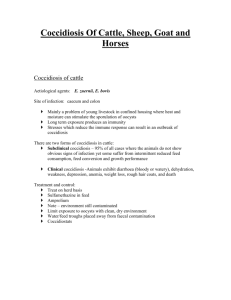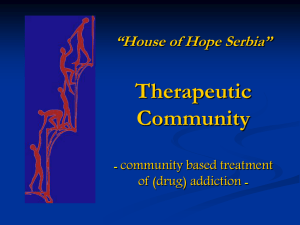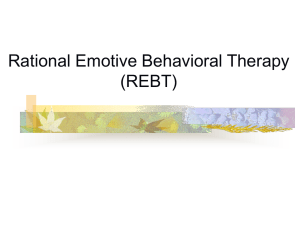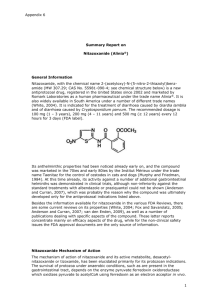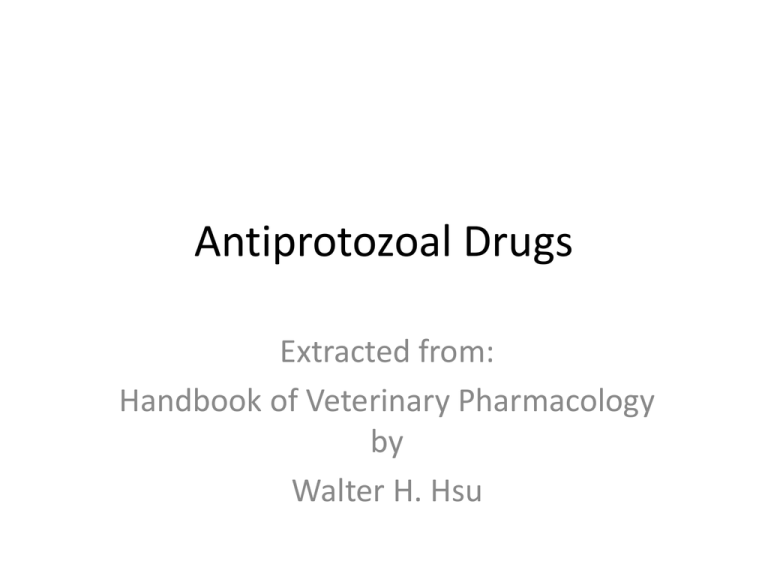
Antiprotozoal Drugs
Extracted from:
Handbook of Veterinary Pharmacology
by
Walter H. Hsu
ANTIPROTOZOAL DRUGS.
This discussion focuses on anticoccidial drugs,
drugs for the treatment of equine protozoal
myeloencephalitis (EPM), toxoplasmosis,
giardiasis, babesiosis, and cryptosporidiosis.
A. Aniticoccidial drugs
1. Introduction
a. Financial implications of coccidiosis. Coccidiosis, a prevalent disease in calves,
piglets, and poultry, costs the US poultry industry >50 million dollars annually,
despite the expenditures of >85 million for anticoccidial drugs. These losses
arecaused primarily by impaired feed conversion, slow growth, and the poor
quality of carcasses at processing.
b. Therapeutic approaches
1) Poultry. Most of the anticoccidial drugs discussed in this section are used in
chickens.
(a) Broilers are not vaccinated against coccidia because latent infection may
retard growth.
(b) Layers are vaccinated against coccidia. Outbreaks are usually treated with a
sulfonamide or diclazuril on an as-needed basis.
2) Sulfonamides and ormetroprim, diclazuril can be used to treat infected
animals, while clopidol, decoquinate, zoalene, amprolium, robenidine,
nicarbazin, and Na+ ionophores can be used to prevent coccidiosis.
c. Resistance to anticoccidial drugs is minimized by using two or more drugs
sequentially. Overemphasized switching may decrease immunity.
d. Life cycle of avian coccidia (Figure 16-8)
FIGURE 16-8. Life
cycle of avian
coccidia and the
effects of
anticoccidial drugs
on the life cycle. All
drugs are effective
during the asexual
cycle only, except
that diclazuril is also
effective during the
sexual cycle. Second
generation schizonts
seem to play an
important role in
gut damages; drugs
affecting this stage
can be used to treat
outbreak. (Modified
from W. M. Reid,
Am. J. Vet. Res.,
36:593, 1975.)
2. Anticoccidial agents
a. Decoquinate
(1) Chemistry. Decoquinate is a quinolone and is lipophilic.
(2) Therapeutic uses
(a) Decoquinate is approved for use in cattle, sheep, goats, and broilers for the
prevention of coccidiosis. It is not effective to treat clinical coccidiosis. It is usually
used as a feed additive.
(b) It is effective against all species of coccidia on the sporozoites stage. Use is limited
because of its tendency to induce drug resistance (due to its action on such an
early stage of the asexual cycle).
(3) Mechanism of action. It halts the development of the sporozoites or trophozoites
of coccidia by inhibiting the electron transport system within parasite mitochondria.
This action is coccidiostatic. In addition, it may block DNA synthesis by inhibiting
DNA gyrase.
(4) Pharmacokinetics. No information is located. No preslaughter withdrawal period is
required. Do not feed to cows, sheep, and goats producing milk for food. Do not use
in laying chickens.
(5) Adverse effects. No adverse effects are seen when the drug is used as directed.
b. Clopidol (Coyden 25)
(1) Chemistry. Clopidol is a pyridinol derivative and is lipophilic.
(2) Therapeutic uses
(a) It is used as a feed additive to prevent coccidiosis in broilers and replacement
chickens.
(b) It is effective against all species of coccidia on the sporozoites stage. Use is limited
because of its tendency to induce drug resistance (due to its action on such an
early stage of the asexual cycle).
(3) Mechanism of action. Clopidol may work similarly to quinolones.
(4) Pharmacokinetics. No information is located. No preslaughter withdrawal period is
required.
(5) Adverse effects. No adverse effects are seen when the drug is used as directed.
c. Zoalene (dinitolmide, Zoamix )
(1) Chemistry. It is a nitrobenzamide.
(2) Therapeutic uses
(a) Zoalene is to be fed continuously as an aid for the prevention and control of
cecal and intestinal coccidiosis in chickens and intestinal coccidiosis in turkeys. It
is not for use in laying birds.
(b) It is effective against all species of coccidia in chickens on the first schizont stage
and can inhibit sporulation of oocysts. Zoalene is often used in combination
with other coccidiostats.
(3) Mechanism of action. Unknown. It might act like nitroimidazoles; it destroys DNA
of parasites.
(4) Pharmacokinetics. No information is located. No preslaughter withdrawal period is
required.
(5) Adverse effects. No adverse effects are seen when the drug is used as directed.
d. Na+ ionophores
(1) Preparations include monensin, lasalocid, narasin, salinomycin, and semduramicin.
These antibiotics are used exclusively as anticoccidial drugs.
(2) Therapeutic uses
(a) Na+ ionophores are effective against all coccidia species in chickens, cattle, and
goats.
i. Monensin is for use in cattle, goats, and broilers.
ii. Lasalocid is for use in cattle and chickens for prevention of coccidiosis.
iii. Narasin, salinomycin, and semduramicin are for use in poultry only.
iv. Na+ ionophores attack the first generation of trophozoites and schizonts.
v. The preslaughter withdrawal is not required. Do not use in veal calves.
Monensin and lasalocid can be used in lactating cows; the milk from these
animals can be safely consumed by humans.
vi. Monensin and lasalocid are also used as growth promoters.
(3) Mechanism of action. Na+ ionophores facilitate the transport of Na+ and H+ into
cells in the rumen, elevating intracellular Na+ and H+ concentrations. As a result,
certain mitochondrial functions (e.g., substrate oxidations) and ATP hydrolysis are
inhibited. Excess intracellular Na+ concentrations accompanied by water can
damage organelles as well.
Na+ ionophores Cont’d
(4) Pharmacokinetics
(a) Monensin in chickens. Following oral dosing, plasma Tmax is ∼0.5 hours and
plasma t1/2 is ∼2 hours. No monensin is detectable in all tissues within 48 hours
of dosing, except for liver, which becomes undetectable within 72 hours of
administration.
(b) Lasalocid in chickens. Following oral administration, t1/2 of serum, liver, and
muscle are 11, 36, and 41 hours, respectively.
(c) Salinomycin in chickens. Following oral administration, residues are present
only at very low concentrations in liver and muscle that fall below the limit of
decision of the assay within 2 days.
(d) No information is available for narasin and semduramicin.
(e) No elimination information is available for mammals regarding Na+ ionophores.
(f) In all species, Na+ ionophores are metabolized in the liver by cytochrome P450
enzymes, and are excreted mostly into bile and feces as parent compound and
metabolites.
Na+ ionophores Cont’d
(5) Adverse effects. These drugs may cause severe cardiovascular and skeletal
muscular side effects.
(a) Increased intracellular Na+ concentrations will damage mitochondria and Golgi
body.
(b) In animal cells, intracellular Na+ further exchanges for extracellular Ca2+,
thereby increasing intracellular Ca2+ concentrations ([Ca2+]i). Lasalocid may
directly facilitate Ca2+ transport into the cells. High [Ca2+]i in cardiac and
skeletal muscle cells are responsible for the main toxic effects of these drugs in
animals.
(c) High [Ca2+]i in chromaffin cells increase catecholamine secretion can further
jeopardize the cardiac arrhythmia. High [Ca2+]i in endocrine cells increase
various hormone secretions.
(6) Contraindications. Horses and turkeys are very sensitive to Na+ ionophores.
Accidental consumption by these animals can be fatal.
e. Amprolium
(1) Chemistry. Amprolium is an analog of thiamine, and is a quaternary compound.
(2) Therapeutic uses. Amprolium is the only anticoccidial agent that can be used in
laying birds and cattle for both the prevention and treatment of outbreaks.
(a) It is effective against the first generation of trophozoites and schizonts.
(b) Amprolium is rarely used alone, because E. maxima, E. mivati, and other species
are resistant to it; combination with antifolate drugs increases the efficacy of
amprolium against these organisms in chickens.
(3) Mechanism of action. Amprolium prevents coccidia from utilizing thiamine by
blocking thiamine receptors.
(4) Pharmacokinetics
(a) Amprolium is poorly absorbed after oral administration.
(b) No preslaughter withdrawal period is necessary.
(5) Adverse effects. Amprolium is a safe drug when used as directed. Neurological
signs and lesions of thiamine deficiency may occur in the host following extremely
high overdoses.
f. Nicarbazin
(1) Chemistry. Nicarbazin is a mixture of 4,4-dinitrocarbanilide (DNC) and 2-hydroxy4,6-dimethylpyrimidine (HOP).
(2) Therapeutic uses. Nicarbazin is approved for use in chickens to prevent coccidiosis
outbreaks.
(a) It is effective against all Eimeria species.
(b) Its peak activity is on second-generation trophozoites.
(3) Mechanism of action. Nicarbazin’s mechanism of action is unknown; however, it is
thought to be via inhibition of succinate-linked NAD reduction and the energydependent transhydrogenase, and the accumulation of Ca2+ in the presence of
ATP.
(4) Pharmacokinetics
(a) Absorption. DNC and HOP are absorbed separately from the digestive tract.
DNC is absorbed more rapidly but disappears more slowly from the tissues than
HOP.
(b) A 4-day withdrawal period is required before broilers are marketed.
(5) Adverse effects
(a) Nicarbazin may bleach brown-shelled eggs, cause mottled egg yolks and poor
hatchability, and impair egg production.
(b) Medicated broilers may be more susceptible to heat stress.
g. Robenidine
(1) Therapeutic uses. Robenidine is approved for use in chickens to prevent outbreaks
of coccidiosis. It is effective against all Eimeria species.
(2) Mechanism of action. The mechanism of action is undetermined. Its peak activity
is on the first generation schizonts.
(3) Pharmacokinetics. The pharmacokinetics of robenidine are not well understood.
(4) Adverse effects. Robenidine imparts an unpleasant taste to the flesh of broilers, if
therapy is not terminated 5 days before slaughter. The taste is imparted to eggs
when birds are fed at dosages equal to or greater than 66 ppm. The ability of
humans to taste robenidine is apparently genetically linked.
h. Sulfonamides have the longest history of use as anticoccidial drugs. These agents
are discussed in detail in Chapter 15.
(1) Preparations. Sulfonamides used most frequently as anticoccidial agents include
sulfadimethoxine, sulfamethazine, and sulfaquinoxaline (long-acting
sulfonamides).
(2) Mechanism of action. Sulfonamides competitively inhibit dihydropteroate
synthase, the enzyme which catalyzes the incorporation of PABA into dihydrofolic
acid. Folic acid is required for purine and DNA synthesis and thus bacterial growth
is inhibited. Mammalian cells and bacteria that use preformed folic acid are not
affected. Sulfonamides are broad spectrum (including protozoa) and bacteriostatic.
(3) Therapeutic uses. These drugs are used for both the prevention and treatment of
coccidiosis outbreaks in all species.
(a) They are more effective against the intestinal than cecal species of coccidia.
(b) Their peak activity is against the second-generation schizonts.
(c) Use of these drugs does not impair immunity development.
i. Dihydrofolate reductase inhibitors
(1) Preparations include ormetoprim and pyrimethamine. Pyrimethamine is not
approved for food animal use.
(2) Mechanism of action. Inhibits dihydrofolate reductase in bacteria (but not
mammalian cells) and thus block the formation of tetrahydrofolic acid essential for
purine and DNA synthesis.
(3) Therapeutic uses. The anticoccidial effects of ormetoprim and pyrimethamine are
synergistic with sulfonamides. They are used to treat coccidiosis outbreaks. The
preslaughter withdrawal period for sulfadimethoxineormetoprim in poultry is 5
days.
(4) Pharmacokinetics. After oral administration, therapeutic levels of ormetoprim are
maintained for ≥24 hours. Other information is not available for animals.
j. Diclazuril (Clinacox )
(1) Chemistry. It is one of benzeneacetonitriles that have potent anticoccidial activity. Diclazuril
is a slightly yellowish to beige powder, and it is almost insoluble in water.
(2) Mechanism of action. Diclazuril is effective against schizonts and gametes by inhibiting
nuclear division.
(3) Therapeutic uses. It is used as a feed additive to prevent coccidiosis in broilers. Since it is
effective against later stages of coccidia, it has potential to be used for treating outbreaks of
coccidiosis. It could be used in an extra-label manner to treat mammalian coccidiosis, EPM,
and toxoplasmosis.
(4) Pharmacokinetics
(a) Following oral administration to chickens, plasma concentrations of diclazuril peak at 6
hours. The plasma and tissue t1/2 are ∼50 hours. There is a rapid equilibrium between
plasma and tissue concentrations of the drug.
(b) The tissue concentrations are 2–10 times lower than the corresponding plasma
concentrations. The liver and the kidneys have the highest concentrations of the drug.
(c) Diclazuril is excreted in the urine mostly as the parent compound. About 50% of the dose
is excreted within 24 hours, and >95% after 10 days.
(d) There is no preslaughter withdrawal time in broilers, since the tissue levels of diclazuril
are below minimal limit after oral administration. Diclazuril is not for use in laying hens.
(5) Adverse effects. Diclazuril is a safe drug when use as directed.
k. Toltrazuril and ponazuril (extra-label use). Ponazuril is toltrazuril sulfone, an active
metabolite of toltrazuril.
(1) Mechanism of action. Toltrazuril and ponazuril are effective against schizonts and
gametes by inhibiting nuclear division.
(2) Therapeutic uses. These are very effective drugs against coccidia, but not yet
approved by FDA for such a use. Ponazuril is approved for use to control EPM.
(3) Pharmacokinetics of toltrazuril. After oral administration to piglets and calves,
toltrazuril is absorbed slowly by the gut, which is followed by longlasting
distribution among the different compartments of the body. The plasma t1/2 is 51
hours in piglets. Excretion is mostly into feces. There is no significant enterohepatic
circulation of toltrazuril. Two metabolites of toltrazuril, both oxidation products,
toltrazuril sulfoxide and toltrazuril sulfone (ponazuril), are found in the tissues and
organs of piglets.
(4) Adverse effects. They include GI disturbances (e.g., vomiting, diarrhea, and
inappetence) and hypersensitivity.
l. Drugs for the control of mammalian coccidiosis. Decoquinate, amprolium,
monensin, lasalocid, sulfonamides with a dihydrofolate reductase inhibitor,
diclazuril, toltrazuril, and ponazuril can be used to prevent coccidiosis.
Sulfonamides with a dihydrofolate reductase inhibitor, diclazuril, toltrazuril, and
ponazuril can be used to treat outbreaks of coccidiosis.
B. Drugs for the treatment of EPM
1. Introduction. EPM is the most important equine protozoal disease in the United
States, which is caused by Sarcocystis neurona. Opossum is the definitive host and
small mammals including cats, skunks, and raccoons are intermediate hosts. Horse is
considered an aberrant, dead-end host for S. neurona. Horses are infected by
ingestion of sporocysts in contaminated feed or water. The schizonts of the asexual
cycle are found in CNS, which cause cerebral damages. The signs of the infection are
manifested by head tilt, ataxia, muscle weakness and atrophy, urinary incontinence,
and constipation.
2. Treatment of EPM
a. Trimethoprim-sulfadiazine and pyrimethamine, PO, daily for ≥30 days (see
Chapter 15, for information on these two drugs).
b. Ponazuril (Marquis), PO, 5 mg/kg/day, 28–56 days.
c. Diclazuril (Protazil), PO, 1 mg/kg/day, 28 days.
d. Nitazoxanide (Navigator), PO, days 1–5: 25 mg/kg; days 6–28: 50 mg/kg.
e. Anti-inflammatory agents. Flunixin, phenylbutazone, and glucocorticoid can be
used to control inflammation.
f. Folic acid/folinic acid for protecting bone marrow.
g. Physical therapy following chemotherapy.
3. Anti-EPM agents
a. Ponazuril (Marquis)
(1) Chemistry. An active metabolite of toltrazuril (sulfone). Toltrazuril is a very potent
anticoccidial drug, but is not approved for use in the United States. Ponazuril is
highly lipophilic.
(2) Therapeutic uses. Ponazuril is for the treatment of EPM, coccidiosis, and
toxoplasmosis. For the treatment of EPM, administer the drug orally, 5 mg/kg/day,
for ≥4 weeks. Relapse occurs in 5–30% cases.
(3) Mechanism of action. Ponazuril is against schizonts by inhibiting nuclear division.
(4) Pharmacokinetics. After daily (5 mg/kg) oral administration to horses, ponazuril
reaches its peak plasma levels in ∼18 days and peak CSF levels in ∼15 days. Peak
CSF levels are 5% of those found in the plasma. Since it is a lipophilic drug, it is
better absorbed on a full stomach. The drug should be given immediately after a
grain meal. The elimination t1/2 of ponazuril is 4.5 days.
(5) Adverse effects. They include blisters on the nose and mouth, skin rash, hives,
diarrhea, colic, and seizures. Do not use in sick or debilitated animals due to other
disorders.
b. Diclazuril (Protazil). The therapeutic uses, mechanism of action, and adverse
effects of diclazuril are the same as those of ponzuril in horses.
(1) Pharmacokinetics. Diclazuril is rapidly absorbed after oral administration, with
peak plasma concentrations occurring at 8–24 hours and a plasma t1/2 of ∼43
hours. When 1 mg/kg of diclazuril is administered PO daily for 21 days, mean
steady-state levels of 20–70 ng/mL in the CSF is reached. The proliferation of S.
neurona is 95% inhibited by diclazuril ≥1 ng/mL.
c. Nitazoxanide (Navigator)
(1) Chemistry. It is a nitrothiazolyl-salicylamide derivative, which is a light yellow
powder and is lipophilic.
(2) Mechanism of action. Nitazoxanide is metabolized into a toxic-free radical from the
“nitro” group, which blocks cellular respiration of protozoans.
(3) Therapeutic uses. 32% nitazoxanide paste is used orally for the treatment of EPM.
During days 1–5, 25 mg/kg; and days 6–28, 50 mg/kg. Nitazoxanide is also used in
humans to treat cryptosporidiosis and giardiasis.
(4) Pharmacokinetics. Following oral administration in horses, nitazoxanide is
absorbed. Time to peak plasma level is 2 hours. Since it is a lipophilic drug, it is
better absorbed on a full stomach. The drug should be given immediately after a
grain meal. It is bound by albumin vividly. The free form of nitazoxanide is
metabolized into acetyl-nitazoxanide and acetyl-nitazoxanide glucuronide and
eliminated in 24 hours in the urine, bile, and feces.
(5) Adverse effects. They include GI disturbances (anorexia, diarrhea, colic, etc.),
enterocolitis, fever, and anaphylaxis (laminitis, edema, etc.). These signs constitute
the “treatment crisis”; one may need to suspend therapy in horses with treatment
crisis.
(6) Contraindications. It should not be administered to horses that are <1 year old;
sick or debilitated for other reasons including hepatic and renal disorders.
C. Metronidazole (Flagyl)
1. Chemistry. A nitroimidazole antiprotozoal and antibacterial agent, metronidazole is
lipophilic.
2. Mechanism of action. A ferrodoxin-linked metabolite of metronidazole disrupts
DNA synthesis in protozoans and bacteria. See Chapter 15 for more information.
3. Therapeutic uses. Metronidazole is a broad-spectrum antiprotozoal drug that is
effective against giardia, histomonas, babesia, trichomonas, and ameba. It is
approved as a human drug, and has been used largely in small animals.
4. Pharmacokinetics
a. Absorption. The oral bioavailability of metronidazole in animals varies 50–100%.
If given in food, absorption is enhanced, attributable to increased bile secretion
that helps dissolve metronidazole. Peak blood levels occur within 1 hour of
administration.
b. Distribution. Metronidazole is rapidly and widely distributed after oral
absorption, because it is highly lipophilic.
c. Metabolism and excretion. Metronidazole undergoes hydroxylation and
conjugation in the liver. Both metabolites and parent drug are eliminated in the
urine and feces in 24 hours. The elimination t1/2 is 4–5 hours in dogs.
5. Adverse effects. High doses of metronidazole or prolonged administration may
induce lethargy, weakness, ataxia, rigidity, anorexia, vomiting, diarrhea, reversible
leukopenia, and hepatotoxicity. Because metronidazole affects DNA synthesis, it may
have teratogenic and carcinogenic effects.
D. Other drugs for treatment of giardiasis
Albendazole and fenbendazole administered orally at 25 mg/kg every 12 hours for 2
days. Albendazole may be toxic to liver and bone marrow and is a teratogen.
E. Drugs for treatment of toxoplasmosis
1. Trimethoprim-sulfadiazine, 15 mg/kg, PO, twice a day for 4 weeks.
2. Pyrimethamine (0.25–0.5 mg/kg) plus sulfadiazine (30 mg/kg), PO, twice a day for 4
weeks.
3. Clindamycin, 10–20 mg/kg, PO or IM, twice a day for 3–6 weeks.
F. Drugs for the treatment of cryptosporidiosis
1. Paromomycin (Humatin). Paromomycin is an aminoglycoside for extra-label use; it
can be very expensive.
a. Administration. It can prevent and treat cryptosporidiosis at 50 mg/kg, PO, twice
a day for 10 days.
b. Pharmacokinetics. No information is available for animals. However, GI
absorption after oral administration is minimal, since it is an aminoglycoside.
c. Adverse effects. Paromomycin induces vomiting, diarrhea, colic, renal toxicity,
and deafness.
2. Azithromycin (Zithromax , 15 mg/kg, PO, twice a day for ≥7 days). It is a
macrolide and inhibits protein synthesis.
3. Nitazoxanide is used in humans for the treatment of cryptosporidiosis.
G. Drug for treatment of babesiosis in dogs
Imidocarb (Imizol)
1. Chemistry. Imidocarb is a diamidine derivative.
2. Mechanism of action. Imidocarb binds to DNA and interfere with parasite
replication.
3. Therapeutic uses. Imidocarb is effective against Babesia canis when given at a single
dose of 6.6 mg/kg IM or SC. Repeat the dose in 2 weeks. Imidocarb eliminates
equine babesia (B. caballi ) when given 1–2 mg/kg, twice during a 24-hour period.
Although effective against bovine babesiosis, imidocarb should not be given to this
species because the withdrawal times have not been determined. Feline babesiosis
is refractory to imidocarb treatment.
4. Pharmacokinetics. Imidocarb is readily absorbed from the injection site. The
elimination t1/2 is ∼3.5 hours. It is excreted mainly into urine and feces as the
unchanged compound.
5. Adverse effects
a. Adverse effects commonly seen are pain during injection and signs of
parasympathetic stimulation such as salivation, nasal drip, or brief episodes of
vomiting. Other effects seen less frequently are panting, restlessness, diarrhea,
and injection site inflammation lasting one to several days. Atropine sulfate can
be used to control the signs of parasympathetic stimulation.
b. Imidocarb is a teratogen and carcinogen, since it affects DNA synthesis. Do not
use in pregnant animals.

